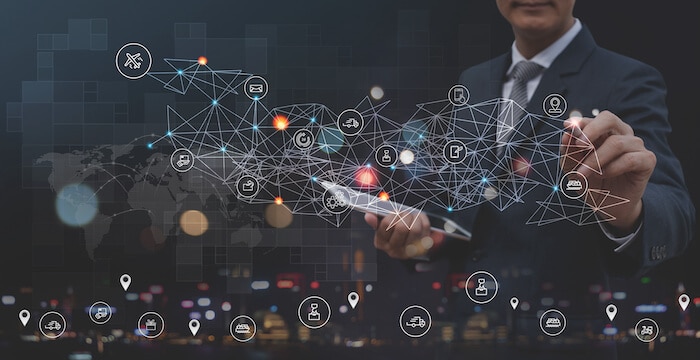Have you thought about your supply chain strategy?
The disruption caused by the COVID-19 pandemic made many more people aware of the term “supply chain.” However, as an entrepreneur bringing a new product to market, you know that the supply chain is much more than what you hear in the news.
Supply chain processes are integral to proper product development—just as critical as your research, design, and manufacturing strategies.
The pandemic has shown us how efficient supply chains can be very fragile. And it overshadowed the tariff battle with China. Picking the right strategy for your product will not only maximize your profit and make you more competitive but also give you the competitive advantage of flexibility when something goes wrong or market demands change.
That is why you should become familiar with supply chain management basics, the types of strategies, and how to plan for disruption.
This article will cover those topics and suggest how to deal with global supply, manufacturing, and distribution in a post-pandemic world and find the right resources to help you on your journey.
What Are Supply Chain Strategies?
Supply chain strategies (or SCM strategies) are methods that organizations use to control the movement of products and services from initial material gathering to final delivery.
These strategies show the main processes, technologies, and partnerships that organizations will utilize to enhance their supply chain’s efficiency and power. A successful supply chain strategy is made up of sourcing, logistics, demand planning, inventory optimization, sales and operations planning, and workforce management.
Having an effective supply chain strategy is crucial for businesses to ensure they can handle customer requirements without compromising on cost efficiency and quality.
The Basics of Strategic Supply Chain Management

There is no need to get a master’s degree in supply chain management (SCM).
You can hire people with that experience, work with global sourcing companies, or use sourcing networks that employ or work with supply chain managers on your behalf.
Entrepreneurs need to know the basics of how all the pieces come together to produce and distribute a product. Every entity involved is part of the supply chain, from mining raw materials to when the customer receives the product on their front doorstep. These supply chain activities are critical for running a successful business.
The entities in your supply network that are linked together in the chain fit into one or more of the following categories:
- Suppliers
- Vendors, consultants, and internal teams
- Warehousing
- Logistics
- Fulfillment
The part of the supply chain people think about the most is purchasing and shipping, but every aspect of product development is a part of the chain. If a step provides resources or adds value, they are part of the chain. The most common functions in the supply chain are product development, marketing, operations, distribution, finance, procurement, and customer service.
Sometimes, these entities are companies or consultants you hire.
Sometimes, they are people or teams within your own company.
The important thing to remember is each of these links comes together to get your product produced and sold. Supply chain planning involves finding the proper entities, setting priorities for procurement, tracking their progress, monitoring supplier performance and making improvements along the way.
Common Supply Chain Strategy Examples

There are many different supply chain management strategies out there, and each expert will have their take on which is the best.
So many strategies exist because every industry has different challenges, and every company has unique priorities. With a high-level understanding of your challenges and priorities, you can help your supply chain experts better pick the right one for your product.
Industry Challenges
Start by understanding the unique supply chain challenges in your industry.
Research into the industry will tell you what your competitors are dealing with and what historical problems others have faced. Some questions you should ask are about your industry are:
- How quickly does technology change?
- How robust is the supplier network for materials and components?
- What is the capacity of the supplier network?
- What technology challenges does the industry face?
- Are there shipping and storage safety issues?
- How volatile is the demand?
- How important is implementing new technologies?
- What are external factors that you have no control over?
- What are customer expectations?
- How well can you forecast customer demand in the short and long term?
Your Priorities
Combining those industry challenges with your business goals and strategy gives you priorities. Effective supply chain management ultimately depends on your broader business strategies and priorities.
When it comes to producing and selling your product, you have to make tradeoffs between four supply chain factors:
- Cost
- Schedule
- Robustness
- Customer value
6 Types of Supply Chain Strategies
With four top priorities and a long list of industry challenges, you can quickly understand why there are so many different strategies. You never want only minimum cost or maximum robustness. You want a tradeoff between everything.
The good news is that almost every one of the supply chain strategies out there fits into one of the six basic types:
1. Efficient Flow
For products with steady and predictable demand, you want to use a strategy where everything works together and all pieces of the supply chain work at the same speed to deliver the product at the required time to the right place.
Inventory management and demand forecasting are critical, and if done right, your inventory levels are always at the right level. You communicate up and down the network constantly. Vendors are chosen because they collaborate well with everyone in the network, building partnerships up and down the chain. You make enough to stock what customers want.
This approach prioritizes customer value, especially availability.
2. Efficient Cost
This is where you maximize the price at every step. The bottom line is in charge. Go with the low-cost provider, manufacturing, and logistics. Change the design to lower the production cost. Price is number one in your market, so you focus on that at every point. You make as many products as possible at one time to keep costs down, so forecasting is critical.
This approach prioritizes cost savings.
3. Efficient Speed
Use this agile supply chain strategy when time to market and adding product variation are critical for your industry. Supply chain costs are less important, and the ability to quickly change your product, manufacturing, and shipping dominates your decision on who to work with. You may work with multiple vendors to optimize scheduling.
This approach prioritizes the schedule.
4. Responsive to Customization
This approach is the way to go if you have a product that requires customization or customer configuration.
You pick your vendors by their ability to deal with unique, low-volume production. They should use automation and advanced manufacturing to integrate customization efficiently into the manufacturing process. The cost is higher, but customer value is high as well. Standard parts are kept in inventory, so customization is quick.
This approach maximizes the ability to customize your product.
5. Responsive to Demand Fluctuation
In industries with variable demand, you want a strategy that allows you to speed up or slow down the entire supply chain quickly and efficiently. This strategy often carries more inventory at every step, so you can spool up fast. Your vendors need to be able to work with short lead times.
This approach maximizes the ability to scale up and down with the market.
6. Responsive to Customer Problems
You use this last strategy when customers look to your products to solve their problems. Customer satisfaction is about doing what other providers can not. Demand is unpredictable, but when customers need what you have, they need it now and they need it with unique features. You don’t make anything until you know exactly what they want. Design and manufacturing work hand-in-hand. You work with vendors who are fast, responsive and communicate clearly. Instead of inventory, you build up capacity.
This approach maximizes value to specific customers.
Supply Chain Risk Management: How To Adapt to Disruptions
You never know which one will show up, so your supply chain strategies should include three basic adaptations, just in case. Each involves multiple solutions for the three critical parts of your supply chain: manufacturing, logistics, and distribution.
The first is the simplest.
Use multiple sources for raw materials and components. You may only purchase from one source but always have one or more backups for every material or component.
The same goes for manufacturing and all the pieces that go into manufacturing.
If you can afford it or disruption would be costly for your product, don’t just identify multiple sources. Use them as part of your supply chain every day. Spread the work around to build robustness.
Shipping deserves its own adaptation because it is the most difficult to predict. Having multiple logistics channels is not just having multiple trans-Pacific shippers. It is about having backup plans for other ways of transporting your goods — maybe rail or air? The options are very product-dependent, but make sure you map out what you will do in the event of natural disasters, or if your primary shipping is literally blocked because a ship is stuck in the Suez Canal.
The last part is your distribution. You may have your Amazon or other e-commerce presence worked out, or space on shelves allocated by a big-box retailer. But what if something goes wrong with them? If your distributors can’t distribute, you are stuck. To be robust for the last part of your supply chain, build and nurture alternative ways to sell your product to your customers.
Post-Pandemic Supply Chain Strategies
One of the most important lessons learned was that you should pay for the insurance.
If you optimize your network assuming no disruptions, those with flexibility and capacity built into the strategy will dominate when the disruptions happen. Toyota recently passed GM as the world’s largest auto manufacturer because its supply chain had inventory and capacity.
The second lesson we can take forward is the importance of having digital supply chain operations that provide real-time information about your product’s production and distribution. Those with access to data and can communicate efficiently and accurately can quickly detect problems, identify bottlenecks, and adapt their business processes.
Use modern Enterprise Resource Planning (ERP) tools as the foundation for a resilient supply chain.
The last and most enduring lesson from the most recent disruption was to have a good understanding of your market. By understanding what they want and when they want it, you can better provide them with the products they want. If you go back to the basics of supply chain management, that is why you have a supply chain.
Having a Supply Chain Strategy Is a Competitive Advantage
Most entrepreneurs bringing a new product to market are focused on other parts of the product design and development process.
To succeed, you must pay as much attention to the network—your supply chain—as possible, and then develop a strategy.
Begin by understanding your industry and clearly establishing your supply chain priorities. Finally, build your team — the companies, consultants, and employees working together to design, produce, ship, and distribute your product.
One way to ensure your success is to use Gembah’s expertise and connections.
We can evaluate your supply chain and help you pick the right approach for your industry, product, and business priorities. There is no reason for you to take this journey alone.
Reach out to Gembah so our supply chain optimization experts can assist with every aspect of your product development process, including setting and managing your supply chain strategy.



